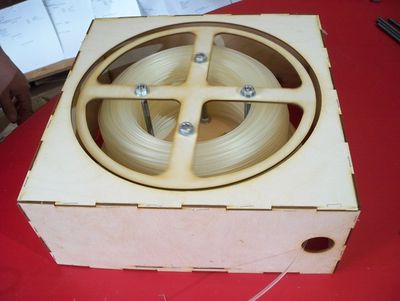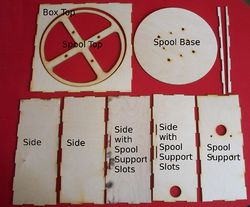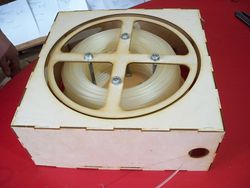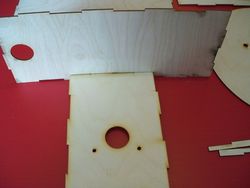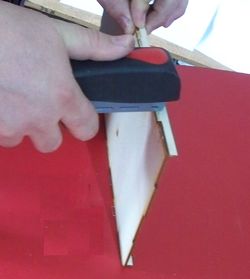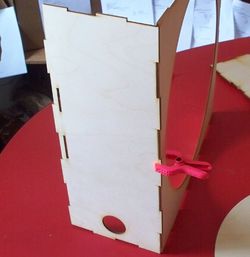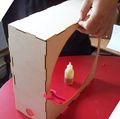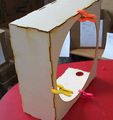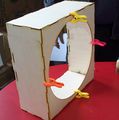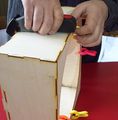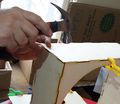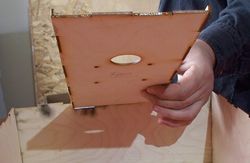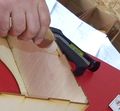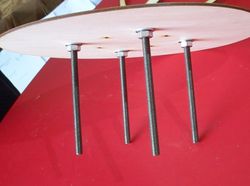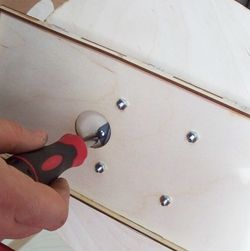TechZone Horizontal Filament Spool
General
This simple filament spool is designed to be inexpensive (both to buy and to ship as a kit) and durable. It is constructed from 3mm plywood, and steel hardware including a lazy susan bearing.
This spool is a great addition to the TechZone Huxley or to the RepRap Mendel, it would of course work with any 3d printer which uses coiled filament.
Release status: unknown
| Description | A simple laser cut filament spool
|
| License | |
| Author | [[User:--Tech Zone Communications]]
|
| Contributors | |
| Based-on | |
| Categories | |
| CAD Models | |
| External Link |
Contents
Files
| FILE ID# | TYPE | DESCRIPTION | AVAILABLE FORMATS | CREATED/RESERVED BY |
|---|---|---|---|---|
| Your-File-Name | MONOTRONICS BOARDS | These are the files you need to make a set of boards | .xml.zip | --Example User 12:00, Today's Date 20xx (UTC) |
| FILE ID# | TYPE | DESCRIPTION | AVAILABLE FORMATS | CREATED/RESERVED BY |
|---|---|---|---|---|
| TechZone Monotronics Firmware | MONOTRONICS Firmware | This file is the firmware for the Monotronics | .zip for use with arduino | --Tech Zone Communications Jan 16, 2011 |
Kit Contents
There are ten LaserCut pieces in the kit as well as a set of steel hardware. The picture at the left shows the LaserCut parts, all are labeled, except for the reinforcements. If you are missing anything from your kit when you unpack it you should contact TechZoneCommunications (if that is where you purchased your kit) and let them know which parts you still need. The Photo on the right shows the assembled spool, and the picture below it shows the contents of the hardware.Click on the images to see them larger.
Assembly
The tools you will want, to make the assembly of this kit simpler, are a common office stapler with staples a screwdriver, some long nose pliars, and Glue. I use polyurethane glue, like gorilla glue, but any other strong glue ment for bonding wood will work just fine. you may also want some small clamps (like spring clamps); and/or large rubber bands.
As the following steps are performed, I used a common office stapler to hold things in place until the glue dried, however, you could use some spring clamps or large rubber bands to hold it together until the glue dries.
The Housing (box)
We are going to start by assembling the spool support. The spool support has five holes in it, one larger and four smaller holes, it is made from thre pieces, the one that matches the preceding description and the two long narrow pieces.To do this correctly, we need to idetify which side of the spool support is the top. I place the spool support into the slots of one of the sides and flip it over if needed, when it is turned the right direction it will appear to be in the center (left to right) as shown in the photo on the right. Take a moment and label the top of this support, so we don't mix it up in the next few steps.
I put glue on the edge of all pieces in the lower portions of the jagged edges which are going to be fastened together (see below). It is smart to dry fit the pieces first to see where you will want this glue, and to make sure the pieces are going the right direction.
The reinforcements should be flush with the top of this support, and project downwards from it.
I have found that an office stapler will work fine to hold things together while the glue dries (not all the staples will penetrate, so just pull out the bad ones with pliars and try again). You could also use some large rubber bands (with blocks underneath to keep it from pulling the reinforcements sideways), or spring clamps like in the picture below.
Use staples to attach each of the other four sides to the top of the box - don't forget to glue the pieces.. If you have some extra help you can glue them in place and hold them with several large rubber bands, rather than with staples. There are pictures of the assembly below to clearify/confuse this step.
I also have a photo of me tapping some of the staples into place, they were still strait, but didn't go in all the way, so I encouraged them a little.
I then put the spool support into the box, the box sides will flex enough to allow spool support so fit (photo at right). I do this with the box upside down, that means the side of the spool support which we marked as top also goes down (see picture below)
I use staples again to hold it in place, but you could stack weights on it instead, or use large rubber bands. (picture of staples below)
The Spool
The spool itself is quite simple, and consists mostly of hardware, there are only two laser cut parts. All the parts used for this section are pictured at the left.I start by putting four of the nuts onto the four threaded rods, almost like the first picture below - I like to put the nuts further onto the rods so that when I put the short end of the rod through the spool bottom, all I have left to do is add nuts to that end.
There are pictures to the right, and below of the rods and nuts connected to the spool bottom. NOTE the picture showing washers on the bottom of the spool is incorrect! if you put washers there, then the nuts and rods stick down too far and it will rub as it spins on the lazy susan bearing, leave the washers off I left the photo because it shows great alignment of the end of the rod and the nuts.
I recommend that you put threadlock on all eight of the nuts that fasten the threaded rod to the bottom of the filament spool.
Then, using the large Access hole in the Spool Support, attach the bearing to the bottom of the spool; as shown on the right.
